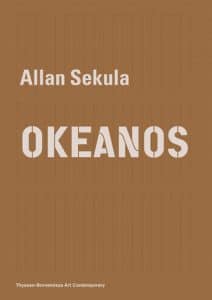 OKEANOS is a posthumous solo-exhibition of Allan Sekula’s maritime-themed œuvre. Allan Sekula (1951–2013), an American documentary photographer and theorist worked on an array of topics and themes. But one of the most significant foci of his work remains the political economy of seafaring.
OKEANOS is a posthumous solo-exhibition of Allan Sekula’s maritime-themed œuvre. Allan Sekula (1951–2013), an American documentary photographer and theorist worked on an array of topics and themes. But one of the most significant foci of his work remains the political economy of seafaring.
The book OKEANOS illustrates, documents, and discusses several projects that focus on shipping in its political, economic, social, and cultural dimensions. In doing so, it documents the OKEANOS exhibition that was on display at Thyssen-Bornemisza Art Contemporary (TBA21) from 21 February–14 May 2017 in Vienna.
The cover of the book has a corrugated bas-relief that resembles the sides of shipping containers and the title refers to Ōkeanós, the Greek god of the sea and descendant of Gaia. The cover thus sums up the essence of the book: the sea as the carrier of cargo that both drives the global economy and damages the planet.
The book contains, and its structure quite suitably containerizes, a series of essays, either by Sekula or on Sekula’s work, and multiple photographic or textual excerpts from the exhibition. The key sections are: Fish Story, Notebooks, Lottery of the Sea, The Forgotten Space, Tsukiji and Case Studies and Maritime Explorations.
Fish Story (1995) starts with a brief excerpt from Sekula’s book on the exhibition of the same name. The combination of image and text is one the defining features of his documentary work. And so is his engagement with Marxist political thought that informed his reading of the maritime industry. This resulted in artistic work, best classified as critical realism, which the curator of the exhibition, Daniela Zyman, argues ‘contributed to the recognition that globalization as we know it would not have been possible without the deregulated physical mobility of goods and commodities on our oceans’ in her essay Not Just a Fish Story (p. 25).
The Forgotten Space (2010), an ‘essay film’ Sekula made with Noël Burch, continues his engagement with the political economy of shipping in shape and form. This film exposes the ‘sea blind’ views on globalized capitalism that conveniently ignore the ever-increasing reliance on cargo shipping to keep the just- in-time economy running just in time. The shipping infrastructure moved from inner-city waterfronts to largely invisible and securely gated facilities in industrial areas. Few cities visibly reveal their reliance on the ocean as the intercontinental highway of cargo transport.
Philip Steinburg’s essay The Ocean as Forgotten Space of Capitalism (first published in 2013 on the blog of Environment and Planning D: Society & Space) highlights the sharp contrast between Fish Story (that reminds us how ‘the ocean’s materiality persists despite the best intentions of capital to wash it away’) and The Forgotten Space (that presents the same ocean ‘as a friction-free surface of movement’) (p. 193). He concludes Sekula’s reading of the ocean shifted from a Foucauldian heterotopia to a neoliberal dystopia: ‘the ocean [Sekula and Burch] have found is merely a dead background for capitalism’ (p. 194).
This raises a pertinent question: has the ocean changed in the 15 years between the two projects, or has Sekula’s reading of the ocean changed? Quite possibly both. But this books offers essays and reflections, not conclusive scientific or historical evidence. Though in the essay Park, an excerpt from Keller Easterling’s book Enduring Innocence (MIT Press 2005), implies that automation may (at least in part) explain the changes that informed Sekula’s shift in interpretation.
Lottery of the Sea (2006) documents the oil spill of the Prestige in 2002. Such oil spills have, for a long time, been the rare moments that shipping made news headlines. The encounter of liquid shipwreck debris and land inspired not only a series of images, but also ‘fragments for an opera’ to be performed on 19 November 2032, 30 years after the oil spill, in the village of Muxia. Though in this case, as with many oil spills, the immediate focus on a malfunction of shipping (an oil tanker leaking its cargo) raises questions around the significant environmental pollution caused by the shipping industry. The International Maritime Organization agreed on its first ever carbon emission target, a reduction of 50 per cent by 2050 on a 2008 baseline.
One section of the book stands out. While every other section addresses a different project by Sekula, this one gives us insights into his modus operandi. It starts with an essay by Sally Stein that discusses excerpts of some of the 142 notebooks in which Sekula documented his thoughts and travels. Stein, an art historian, but also Sekula’s widow, stresses she never ‘breached’ the privacy of these notebooks while he was alive (p. 63). The notebooks reveal granular detail about the way Sekula developed his ideas and sometimes decided against developing them further. Somewhat ironically, the facsimile of these notebooks illustrate his love for words that made him as much a theorist as a photographer.
The book is mainly an exhibition catalogue. But it is also an excellent introductory overview of some of Sekula’s key works on the political economy of seafaring. While the ‘catalogue’ approach of the book means that it lacks a clear introduction and conclusion, these omissions are by design. The introduction the book provides is rather an open narrative that provides access to unique personal notebooks, reprints sections from otherwise rare publications (Fish Story is out of print, and at the time of writing, the two second-hand copies available on Ebay sell for US$224.95 and US$404.91, quite suitably excluding shipping costs), and includes the script ‘essay film’ The Forgotten Space (which lacks wide distribution). [2019 update: Mack Books republished Fish Story.]
The editors, Daniela Zyman and Cory Scozzari (also the curator and assistant curator of the exhibition), have created a fascinating, insightful, and timely overview of Sekula’s selected maritime work. This collection goes well beyond merely disclosing content and documenting the exhibition at TBA21. It is an indispensable homage to the thought and work of Allan Sekula.
–
First published in The Mariner’s Mirror, 104(3), 2018.
Allan Sekula: OKEANOS. edited by Daniela Zyman and Cory Scozzari. Sternberg Press, Berlin, 2017, €29.00 (softcover), 277 pages, colour illustrations. ISBN 978-3-95679-337-0.
